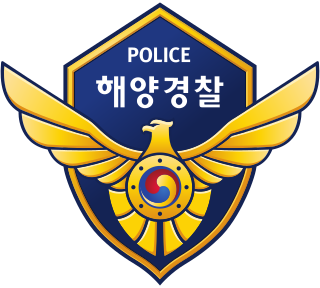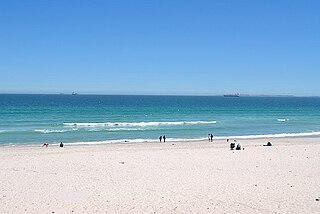
The International Maritime Organization is a specialised agency of the United Nations responsible for regulating maritime transport. The IMO was established following agreement at a UN conference held in Geneva in 1948 and the IMO came into existence ten years later, meeting for the first time on 17 March 1958. Headquartered in London, United Kingdom, the IMO, in 2024, has 176 Member States and three Associate Members.

A coast guard or coastguard is a maritime security organization of a particular country. The term embraces wide range of responsibilities in different countries, from being a heavily armed military force with customs and security duties to being a volunteer organization tasked with search and rescue without law enforcement authority. In most countries, a typical coast guard's functions are distinct from those of the navy and the transit police, while in certain countries they have similarities to both.

Search and rescue (SAR) is the search for and provision of aid to people who are in distress or imminent danger. The general field of search and rescue includes many specialty sub-fields, typically determined by the type of terrain the search is conducted over. These include mountain rescue; ground search and rescue, including the use of search and rescue dogs ; urban search and rescue in cities; combat search and rescue on the battlefield and air-sea rescue over water.

The United States Merchant Marine is an organization composed of United States civilian mariners and U.S. civilian and federally owned merchant vessels. Both the civilian mariners and the merchant vessels are managed by a combination of the government and private sectors, and engage in commerce or transportation of goods and services in and out of the navigable waters of the United States. The Merchant Marine primarily transports domestic and international cargo and passengers during peacetime, and operate and maintain deep-sea merchant ships, tugboats, towboats, ferries, dredges, excursion vessels, charter boats and other waterborne craft on the oceans, the Great Lakes, rivers, canals, harbors, and other waterways. In times of war, the Merchant Marine can be an auxiliary to the United States Navy, and can be called upon to deliver military personnel and materiel for the military.

Flag of convenience (FOC) is a business practice whereby a ship's owners register a merchant ship in a ship register of a country other than that of the ship's owners, and the ship flies the civil ensign of that country, called the flag state. The term is often used pejoratively, and although common, the practice is sometimes regarded as contentious.
Responsibilities for traditional coast guard duties in Australia are distributed across various federal, state and community agencies. The de facto coast guard of Australia is the Maritime Border Command, a joint command of the Australian Defence Force and the Australian Border Force which works alongside the Australian Federal Police, the Australian Fisheries Management Authority, and the Australian Maritime Safety Authority. Each state and territory government have specific maritime safety agencies and police marine units. In addition, there are several private volunteer coast guard organisations which act as auxiliary search and rescue services and maritime safety educators with the largest organisations being the Royal Volunteer Coastal Patrol established in 1937, the Australian Volunteer Coast Guard established in 1961, and Marine Rescue New South Wales established in 2009.

The Port of Hong Kong located by the South China Sea, is a deepwater seaport dominated by trade in containerised manufactured products, and to a lesser extent raw materials and passengers. A key factor in the economic development of Hong Kong, the natural shelter and deep waters of Victoria Harbour provide ideal conditions for berthing and the handling of all types of vessels. It is one of the busiest ports in the world, in the three categories of shipping movements, cargo handled and passengers carried. This makes Hong Kong a Large-Port Metropolis.
A second mate or second officer (2/O) is a licensed member of the deck department of a merchant ship holding a Second Mates Certificate of Competence, by an authorised governing state of the International Maritime Organization (IMO). The second mate is the third in command and a watchkeeping officer, customarily the ship's navigator. Other duties vary, but the second mate is often the medical officer and in charge of maintaining distress signaling equipment. On oil tankers, the second mate usually assists the chief mate with the cargo operations.

The Marine Department of the Hong Kong Government is responsible for maintaining safety and environmental protection of the harbour, ships registered/foreign ships in Hong Kong and monitor shipping traffic in Hong Kong waters, search and rescue operations for large waters of the South China Sea.

The Maritime Safety Administration of the People's Republic of China is a government agency which administers all matters related to maritime and shipping safety, including the supervision of maritime traffic safety and security, prevention of pollution from ships, inspection of ships and offshore facilities, navigational safety measures, administrative management of port operations, and law enforcement on matters of maritime safety law. It was also responsible for marine accident investigation. It is headquartered in Dongcheng District, Beijing.

Australian Maritime Safety Authority (AMSA) is an Australian statutory authority responsible for the regulation and safety oversight of Australia's shipping fleet and management of Australia's international maritime obligations. The authority has jurisdiction over Australia's exclusive economic zone which covers an area of 11,000,000 square kilometres (4,200,000 sq mi). AMSA maintains Australia's shipping registries: the general and the international shipping registers.
A marine surveyor is a person who inspects, surveys, or examines marine vessels in order to assess damage, inspect aberrations, or monitor their condition and that of any cargo on board. Marine surveyors also inspect equipment intended for new or existing vessels to ensure compliance with various standards or specifications. Marine surveys typically include the structure, machinery, and equipment in addition to the general condition of a vessel and/or cargo. They also involve judging materials on board and their condition. Though a largely unregulated profession, marine surveyors are generally trained specifically for the role and usually selected after thorough evaluation procedures. Their duties apply to a wide range of seafaring vessels.

The Korea Coast Guard is a South Korean law enforcement sub-agency responsible for maritime safety and control off the coast. The KCG is an independent and external branch of Ministry of Maritime Affairs and Fisheries.

The National Cargo Bureau (NCB) a not-for-profit marine surveying organization charged with assisting the U.S. Coast Guard with carrying out the provisions of the International Convention for the Safety of Life at Sea. The NCB was formed by a group of marine underwriters and the Coast Guard for the purpose of reducing losses of grain ships. Any ship loading grain in the US sailing for a foreign port must have a certificate issued by the NCB in order to sail( See U.S. Coast Guard Navigation and Vessel Inspection Circular No. 5-94 - NVIC 05-94 ). The NCB acts with and enforces the regulations of the Coast Guard in this area. Grain ships have unique stability issues and are prone to capsize if loaded improperly. Headquartered in New York City, the NCB has offices throughout United States.

Maritime New Zealand is a Crown entity and also a state maritime safety authority responsible for protecting the maritime transport sequence and marine environment within New Zealand and maintaining safety and security.

S. A. Agulhas is a South African ice-strengthened training ship and former polar research vessel. She was built by Mitsubishi Heavy Industries in Shimonoseki, Japan, in 1978. S. A. Agulhas was used to service the three South African National Antarctic Programme research bases, Gough Island, Marion Island in the Southern Ocean and SANAE IV in Antarctica, as well as various research voyages.

The MV Seli 1 was a Turkish bulk carrier, operated by TEB Maritime of Istanbul, that was en route to Gibraltar when it was driven aground off Bloubergstrand near Table Bay, South Africa by strong westerly winds shortly after midnight on 8 September 2009, having reported engine failure and a snapped anchor chain.
MT Phoenix was a tanker which went aground in heavy seas at Sheffield Beach just north of Ballito near Durban, South Africa on the morning of 26 July 2011. The vessel was on its way to India to be scrapped when it ran aground. After three attempts, it was refloated, towed and then scuttled and sunk in 2,000 metres (6,600 ft) of water, about 80 kilometres (43 nmi) offshore of Amanzimtoti, south of Durban. The vessel was reportedly owned by either Suhair Khan of Dubai or Marika Investments, Lagos, Nigeria.
The International Federation of Shipmasters' Associations (IFSMA), is the international professional organisation that unites and represents the world's serving Shipmasters.
The Danish Maritime Authority is the agency of the Danish Government responsible for regulating and administrating Danish maritime affairs. The Danish Maritime Authority (DMA) is part of the Ministry of Industry, Business, and Financial Affairs. The Agency consists of the central authority and eight vision offices, including the office in Nuuk and the Centre for Maritime Health on Fanø. Its headquarters are in Korsør.















